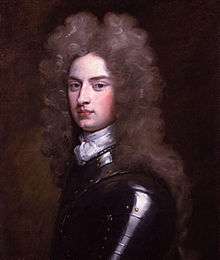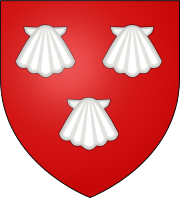Arnold van Keppel, 1st Earl of Albemarle
Arnold Joost van Keppel, 1st Earl of Albemarle, KG, and lord of De Voorst in Guelders (Gelderland) (Dutch: [ˈɑrnɔl coːst fɑŋ ˈkɛpəl];[1] baptised 30 January 1670 – 30 May 1718), was a Dutch military leader who fought for King William III of England and became the first Earl of Albemarle. He was the son of Oswald van Keppel and his wife Anna Geertruid van Lintelo.[2] De Voorst is a large country house near Zutphen, financed by William III, and not unlike the royal palace Het Loo in Apeldoorn.
| |
|---|---|
 The Earl c. 1700. | |
| Earl of Albemarle | |
| Tenure | 1697–1718 |
| Predecessor | New creation |
| Successor | William van Keppel |
| Full name
Arnold Joost van Keppel | |
| Baptised | 30 January 1670 Zutphen, Dutch Republic |
| Died | 30 May 1718 (aged 48) |
| Noble family | De Voorst |
| Spouse(s) | Geertruid Johanna Quirina |
Issue
| |
| Father | Oswald van Keppel |
| Mother | Anna Geertruid van Lintelo |
| Military career | |
| Allegiance | |
| Years of service | 1703–1718 |
| Battles/wars | War of the Spanish Succession |
Life
Arnold Joost van Keppel was born in Zutphen in the Dutch Republic about 1670 and was the heir of a junior branch of an ancient and noble family in Gelderland, and 12th in descent from Walter van Keppel, living in 1179. He achieved fame and wealth as the right-hand man of William III of Orange. He became page of honour to William III in his mid-teens, possibly as early as 1685.[3][4] It has been claimed that he was William's lover, but no conclusive evidence has been discovered. Keppel accompanied William to England in the Glorious Revolution of 1688.[2]
While some have suggested their association began when Keppel was only 16, others argue a later date, possibly at the time of a hunting accident when he is said to have attracted the king's attention by his uncomplaining demeanour upon breaking a leg.[5][6] Public commentary on the relationship intensified in 1692 when Keppel began to receive grants of land from the king.[7] He became Groom of the Bedchamber and Master of the Robes in 1695. In 1696, he was created the Viscount Bury in Lancashire, and the Baron Ashford of Ashford, Kent. On 10 February 1697, William made Van Keppel the Earl of Albemarle.[2] In 1699, he was awarded the command of the First Life Guards.[8]
_6.395_-_ARNOLD_JOOST_VAN_KEPPEL%2C_EARL_OF_ALBEMARLE_K.G._(by_Sir_Godfrey_Kneller).jpg)
In 1700, William gave Albemarle extensive lands in Ireland, but Parliament obliged the king to cancel this grant. William instead granted him £50,000. The same year he was created a Knight of the Garter.[2] He served both with the English and Dutch troops, was major-general in 1697, colonel of several regiments and governor of 's-Hertogenbosch.
Handsome and engaging, he rivalled Portland (whose jealousy he aroused in the royal favour), possessed William's full confidence, and accompanied him everywhere. In February 1702 William, then prostrated with his last illness, sent Albemarle to the Netherlands to arrange the coming campaign, and he only returned in time to receive William's last commissions on his deathbed,[9] including being entrusted with the king's private papers.[8]
After the death of William III, who bequeathed to him ƒ200,000 and the lordship of Bredevoort,[10] Albemarle returned to the Netherlands, took his seat as a noble in the States-General, and became a general of cavalry in the Dutch army. He joined the forces of the allies in 1703 in the War of Spanish Succession, was present at the Battle of Ramillies in 1706, and at Oudenaarde in 1708, and distinguished himself at the siege of Lille. He commanded at the siege of Aire in 1710, led Marlborough's second line in 1711, and was general of the Dutch forces in 1712, being defeated at Denain after the withdrawal of Ormonde and the English forces and taken prisoner. He died on 30 May 1718, at the age of forty-eight.[11]
Family

Albemarle married Geertruid Johanna Quirina, daughter of Adam van der Duyn (nl),[12] by whom he had :
- William Anne, who succeeded him as 2nd Earl of Albemarle. He married the granddaughter of Charles II of England
- Sophia (1716–1773), who married General John Thomas. They had at least two sons. The younger son, Colonel Charles Nassau Thomas, became Vice-Chamberlain to George IV, when he was Prince of Wales.[13]
Among his direct descendants are both wives of Prince Charles (Diana, Princess of Wales, and Camilla, Duchess of Cornwall), and author Violet Trefusis, who was a daughter of Alice Keppel (Alice Frederica Keppel, née Edmonstone), royal mistress of Edward VII, George Keppel, son of the 7th Earl of Albemarle, and Sarah Ferguson, Duchess of York.
References
- In isolation, Arnold, Joost and van are pronounced [ˈɑrnɔlt], [joːst] and [vɑn], respectively.
- Chisholm 1911, p. 492.
- Fifty years of my life By George Thomas Keppel Albemarle (Earl of); p. 303.
- Mrs. Keppel and Her Daughter By Diana Souham; p. 19.
- Royal mistresses By Charles Carlton; p. 93.
- The Anglo-Dutch favourite By David Onnekink: p. 229.
- Perilous enlightenment By George Sebastian Rousseau; p. 24.
- Memoirs of the court of England from ... 1688 to the death of George the second By John Heneage Jesse; p. 235.
- Chisholm 1911, pp. 492–493.
- Ada Peele, Een uitzonderlijke erfgenaam: De verdeling van de nalatenschap van Koning-Stadhouder Willem III en een consequentie daarvan: Pruisisch heerlijk gezag in Hooge en Lage Zwaluwe, 1702-1754 (Hilversum: Verloren, 2013), pp. 53–54.
- Chisholm 1911, p. 493.
- Van der Aa, Nieuw Nederlandsch Biografisch Woordenboek, p. 436.
- The Correspondence of Horace Walpole by Horace Walpole, 4th Earl of Orford; p. 131.
Attribution:

- Edmund Lodge The Genealogy of the Existing British Peerage, 1859. at Google Books
| Military offices | ||
|---|---|---|
| Preceded by The Earl of Scarbrough |
Captain and Colonel of His Majesty's Own Troop of Horse Guards 1699–1710 |
Succeeded by The Earl of Portland |
| Court offices | ||
| Preceded by William Nassau de Zuylestein |
Master of the Robes 1695–1701 |
Succeeded by Cornelius Nassau |
| Peerage of England | ||
| New creation | Earl of Albemarle 1697–1718 |
Succeeded by William van Keppel |